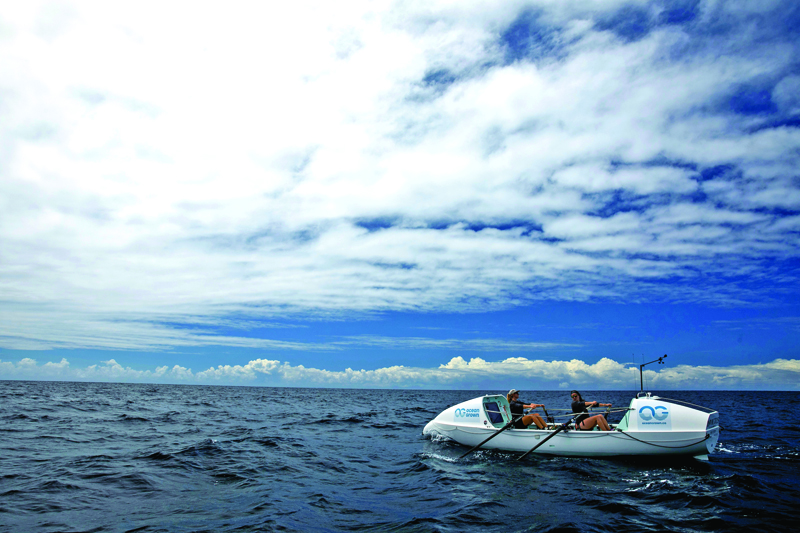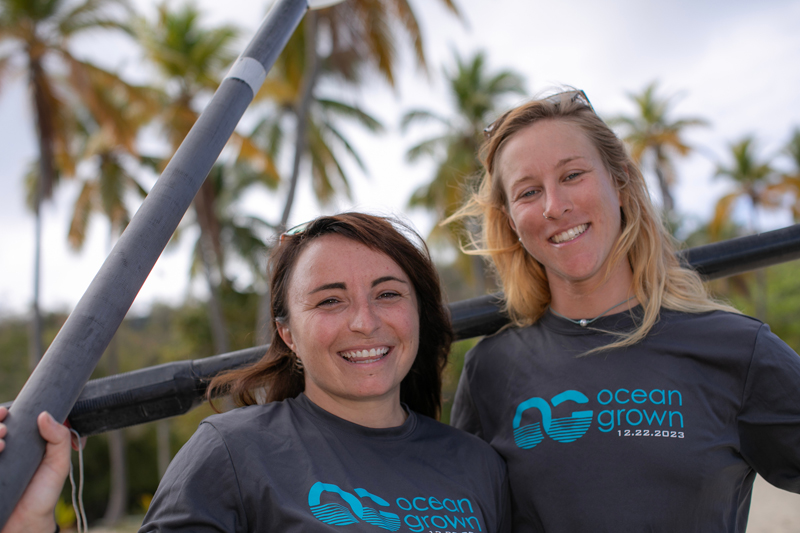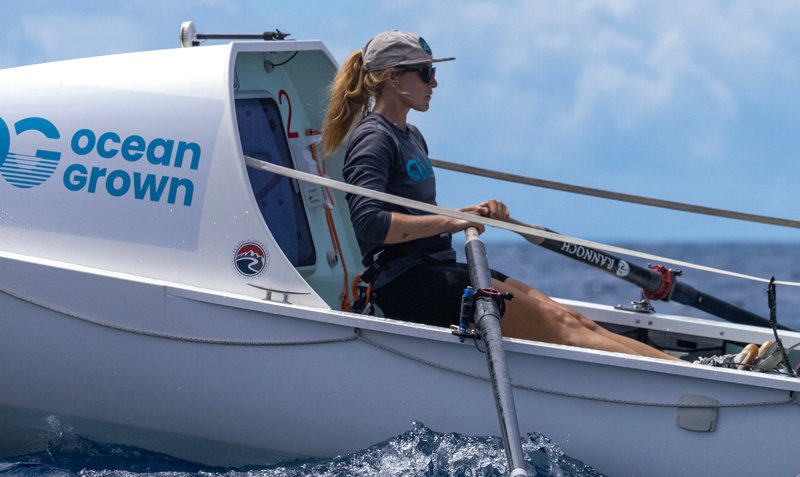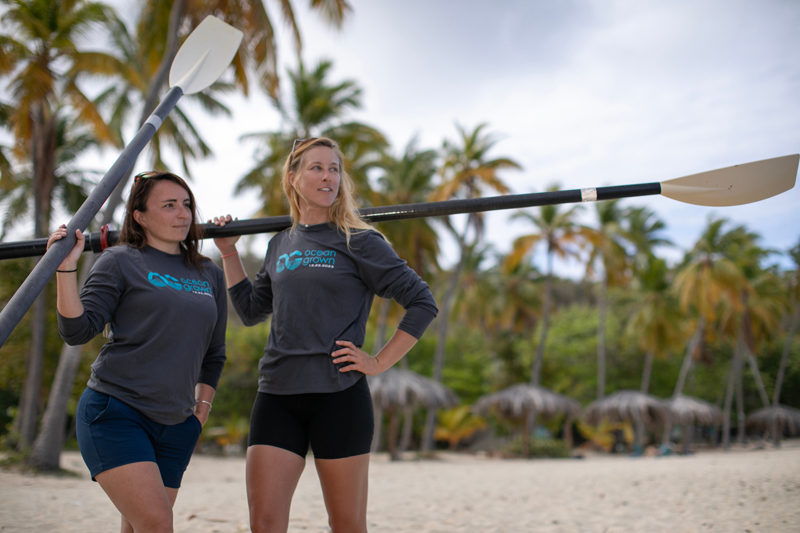Two women, four oars, one ocean
Annapolis sailor “Nini” (Lauren) Champion, who is preparing to row across the Atlantic in December, with her Canadian friend, Lisa Roland, 31, is not worried about the 25-foot boat, or the weather, or the fact that many people think she is just plain crazy.

“The hardest part is making it to the start line,” Champion, 30, said.
Champion’s Team OceanGrown is one of only two women teams of 11 competing in the pair event of the 2023 ocean rowing race. There are other things that set them apart. Both women work in the professional sailing industry, and with 60,000 nautical miles between them, believe their experience with navigation and life at sea will help them in taking on the Atlantic by rowing vessel this December. They are raising money for kids who have aged out of foster care to pursue careers in the maritime industry.
Their race—rowing 3000 miles across the Atlantic Ocean from the Canary Islands to English Harbor, Antigua—is no longer just an extreme sport feat; it has become a regular event which has an audience and enthusiasts, rules, prizes, and even a history.
“We’ve been working on this project for three years, and we’re almost there,” Champion said in an interview with SpinSheet. In a way, she is lucky; because the number of people planning to do “The World’s Toughest Row” (2023) has grown so large that the 2024 and 2025 events have already sold out.
Previously called the Talisker Whiskey Atlantic Challenge, now retitled The World’s Toughest Row, is the best known of a growing number of ocean rowing events in both the Atlantic and Pacific oceans, attracting modern adventurers who want to test the limits of human endurance, the limits of training, and perhaps the limits of “mental fortitude,” says Champion. The row for a pairs team averages 60 days to complete, though team Ocean Grown is pushing to reach the finish in less than 45 days, seven hours, and 25 minutes to set a new female pairs record.
During much of that time either Champion or Roland will be at their two sets of carbon fiber oars, sitting on sliding seats and pushing their boat, toward a faraway continent. They will be going backwards of course, for that’s how rowers row, at an estimated speed between two and four knots.
As might be suspected, the late SpinSheet photographer Dave “Toots” Dunigan, who died this spring at 74, had cheered the pair of young women on. “I think they are crazy,” Dunigan told me, “but they’re going to do it. More power to them.”

New sport and craft
Rowing was once the venue of short excursions in ordinary one man (or woman) racing boats, called sculls, and always in calm or enclosed water. A Chesapeake example is the annual “Wye Island” regatta, a rowing circumnavigation of the Eastern Shore island. But all has changed. Instead of straight-line racing for 2000 meters—the Olympic rowing protocol, which takes a highly trained athlete about seven minutes (more or less) and is done on rigorously prepared courses, the flattest possible water, and summer conditions—the new ocean sport is done on the North Atlantic (admittedly in the historic “trade wind” route of the world of sail freight). It’s done to make the task as difficult as possible.
Now the competing craft are double-ended straight keelboats specially built for the ocean, with tiny sleeping spaces, GPS satellite tracking, a camping-style galley with gimbals, osmosis water converters, a small rudder, an extensive list of safety gear—but absolutely no sails. Sails are a no-no. While an Olympic sculling boat weighs about 30 to 40 pounds, their ocean rowing vessel Invictus weighs 1800 pounds.
Designer and builder of most of the competing craft is Charlie Pitcher, 60, a rowing and sailing athlete who has competed at a high level (America’s Cup, Admiral’s Cup) in the sailing world, and holds a record in the ocean-rowing world with a 35-day 2013 row from La Gomera to Port St. Charles, Barbados. He also won the 2009 race.
“I saw a niche in the market,” Pitcher recalls. He set up manufacturing at Burnham on Crouch in the south of England in 2009 and now claims that his boats have entered and won in every category of ocean rowing.
He has built solo, pair, three-oar, fours, fives and a much larger concept, Roxie, a 12-person ocean rowing boat with eight rowing positions, offering eight berths. Pitcher has built more than 130 ocean rowing boats as the racing event expanded and changed: at first it was the Atlantic Challenge, then the Woodvale event, then the Atlantic Campaign in 2012, and until last year the Talisker (now World’s Toughest Row).

How hard can it be?
The difficulties of rowing rather than sailing need little explanation. Rowing into a strong headwind is very challenging, and contestants deploy a bag-like sea anchor just to try not to go backwards so fast. Rowing with a strong tail wind is better; winds bring waves, which crash against the oars, measuring more than six feet. Rowing two up is faster, with both people working, but there is the matter of fatigue and rest, both necessary in a 24-hour, non-stop effort. The customary southeast trade wind is the best condition for making progress and also a reason that the course is set from the Canaries to Antigua.
Atlantic Campaigns supervises racing. Races are accompanied by two safety vessels, plus land-based officials following progress via GPS tracking devices.
Champion and Roland have been training for more than a year. Considering conditions, it may be faster to row “two up” with both women rowing, or inevitably “one up,” as athletes must sleep. At times, past competitors have stopped rowing altogether, drifting backwards as slowly as possible with a canvas sea anchor deployed.

The team
Roland and Champion met three years ago, as they both ran yachts as professional sailors. Lisa Roland, a partner in a catamaran charter business (Unplugged Yacht Charters) in Antigua, BVI, is a Canadian with personal life experience she has turned into her mission: she was a foster child and wants to create scholarships which could feed foster children into careers in the yacht crewing world, aka the sailing industry.
The rootless life of a foster child first inspired her with the idea of linking foster care with the maritime industry. She knew the life of moving from ship to yacht to racing machine to powerboat and back to shore for the very seasonal work that exists.
“Nini” Champion grew up in Annapolis, sailed at the Annapolis Yacht Club and Severn Sailing Association, and cruised in the family’s Hylas. After graduation from the University of Maryland, she began the life of a professional sailor.
The competitors
The race has drawn the widest variety of entrants; for the “Pair Event” in which Roland and Champion are entered, there are a dozen entries predominantly from the United Kingdom. Champion explains that American regulations create an extra burden for them, because their boat, built like most of the other competing vessels by Rannoch Adventures of Burnham on Crouch, Essex, UK, must pass US import restrictions and will be shipped in a container on a freight ship to the starting area in La Gomera, Canaries.
There are five teams of British “pairs” (meaning two people, four oars), one Irish pair, one USA and Australian pair, one Scottish pair, and one German pair. Nini and Lisa, who count USA and Canada as homelands, round out the field. Their logical rivals are the only other women’s team: a Scottish pair, “She rOars,” Sabrina Simpson and Leanne Maiden.
As sailors and young women, Roland and Champion rail against the usual role of women on fully crewed racing boats: “We wanted to be on the foredeck,” Champion says.
She crewed aboard Taz, a Rachel Pugh 37, and has worked for The Rigging Company of Annapolis, which has recently expanded with a base in St. Thomas. Roland served as an officer on a tall ship and has experience captaining on a superyacht.
Sailing experience gives them an edge, Lisa explains, for every wind change gives them a chance of taking a fresh “slant” or attempting to choose the most favorable angle to the wind to steer.
The two alternate between training sessions in the Virgin Islands and fundraising at home in Annapolis.
Masters of their fate
Nini and Lisa were already friends when ocean rowing came up. Lisa had been in Antigua when the finishers at a previous Tallisker Ocean Race came in, spreading excitement for a while. Nini has a big ocean rowing credit: she had done the “Around Scotland” rowing contest one year. She has skippered and co-skippered two expeditions in Rannoch Adventures 12-person ocean racing boats. Lisa then had a big idea. She’d noticed that competitors usually had to come up with a cause for which to raise money. She realized that in her own life she had the reason and the angle.
They found a used boat (built by Pitcher) named Invictus, and that struck the right note. The Navy men they met already knew the words to the poem by W.E. Henley. They decided to keep the name for the famous lines: “I am the master of my fate; I am the captain of my soul.”
Roland said, “My life experience is behind what we are doing. I grew up not really having a family unit, but in my sailing life, the onboard environment became my family.”
As a paid hand, she rose through the grades of expertise, from deckhand to mate to yacht master and on to captain, depending on the size and type of yacht. (Since its founding in 1970 the worldwide Royal Yachting Association has offered courses to regulate training for young people who want to make a living doing yacht work.)
That was the missing connection she sought: Roland would connect foster children with their natural cohort, yacht crews and other maritime positions.
Through hell or high water
Ocean rowing goes way back to the days when dory men off the Grand Banks of Newfoundland were stranded by storms, and they either found land or drowned unknown and unreported. In 1896 two Norwegian seamen, Frank Samuelsen and George Harbo, rowed from New York to the Scilly isles in 55 days using four oars in a lapstreak oak rowing boat as an unsponsored venture.
As a dare or contest it began again with Chay Blyth, the British Army paratrooper, who with fellow paratrooper John Ridgway rowed an open dory across the Atlantic west to east in 92 days in 1966. Blyth went on to gain a knighthood after his singlehanded circumnavigation in British Steel in 1970 in 290 days.
The contest emerged from obscurity in 2005 when world champion and two-time Olympic gold medalist James Cracknell and Brit reality TV announcer Ben Fogle made a well-publicized entry and a hit television documentary about the Atlantic row.
Aptly dubbed “Through Hell and High Water,” the film records near disaster when a capsize wrecked their electronics and their electric-powered watermaker quit, forcing them to use emergency water, which under the rules cost them first place. Fogle suffered a near nervous breakdown because of thirst, loneliness, and boredom, but Champion and Roland are unfazed.
by Duncan Spencer
To donate and learn more, visit oceangrown.co or visit Team Ocean Grown on Facebook and Instagram.




